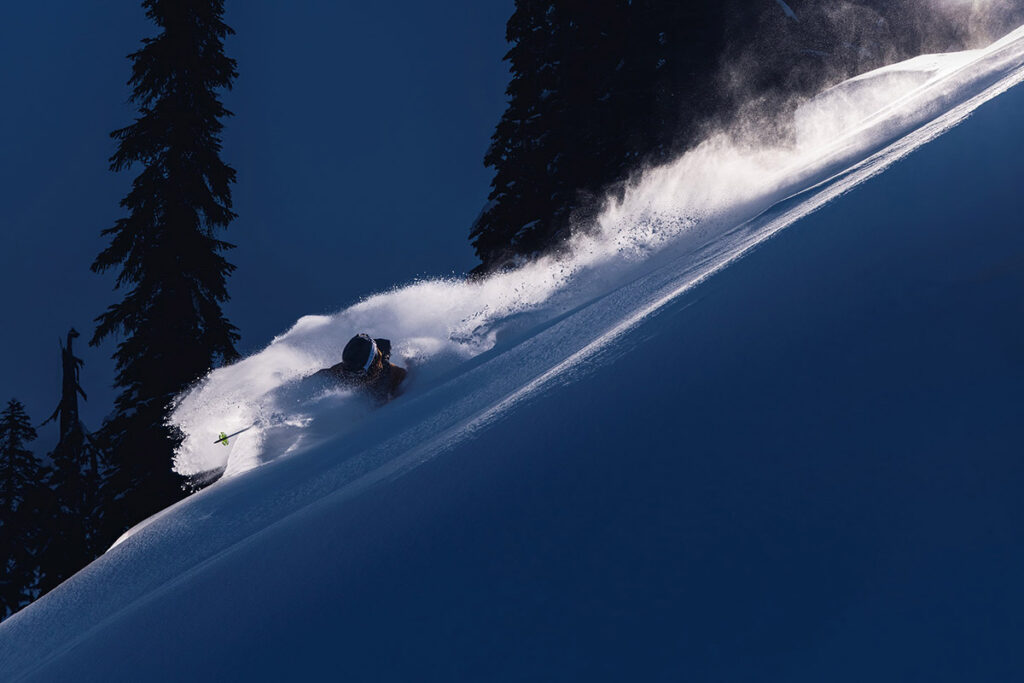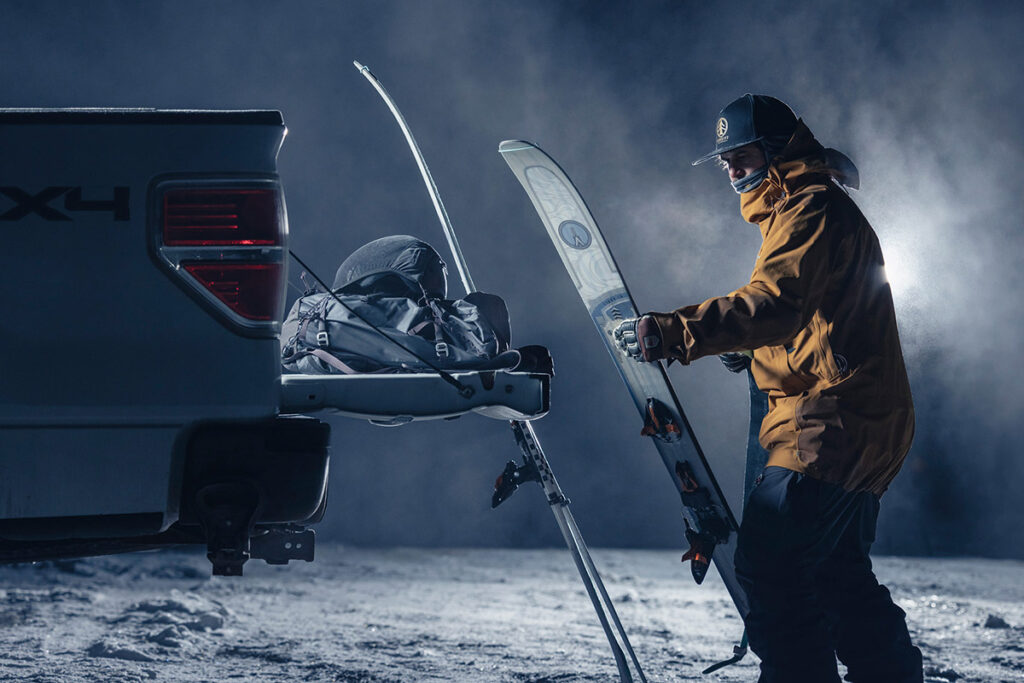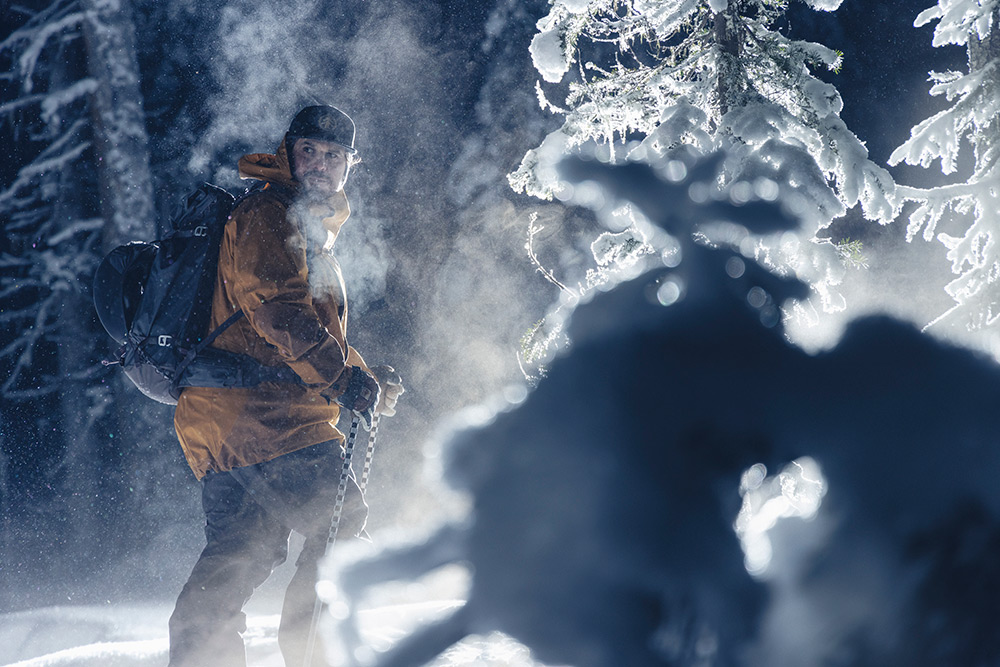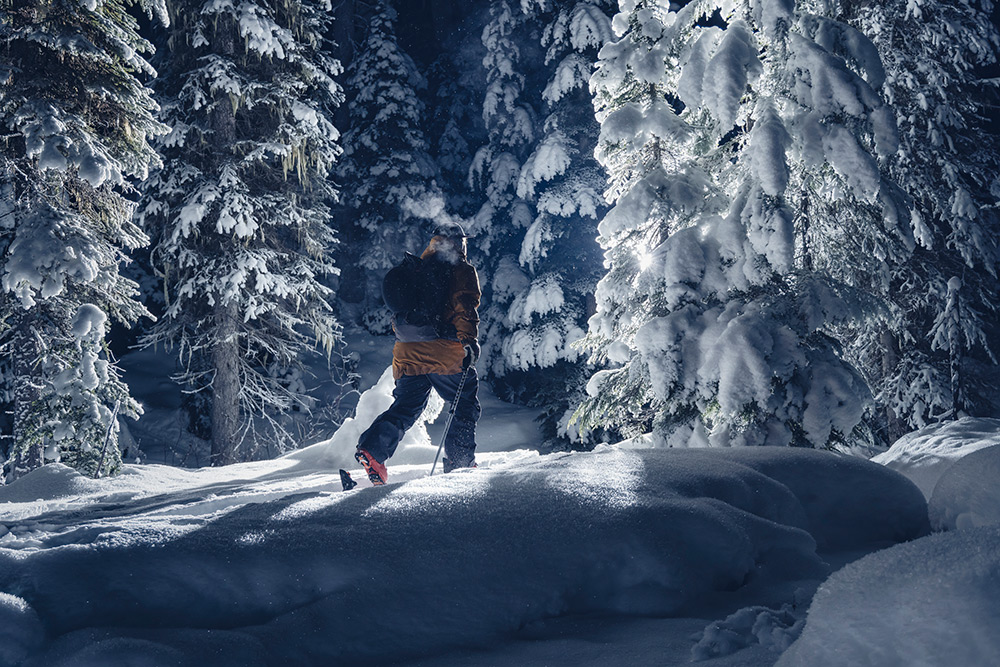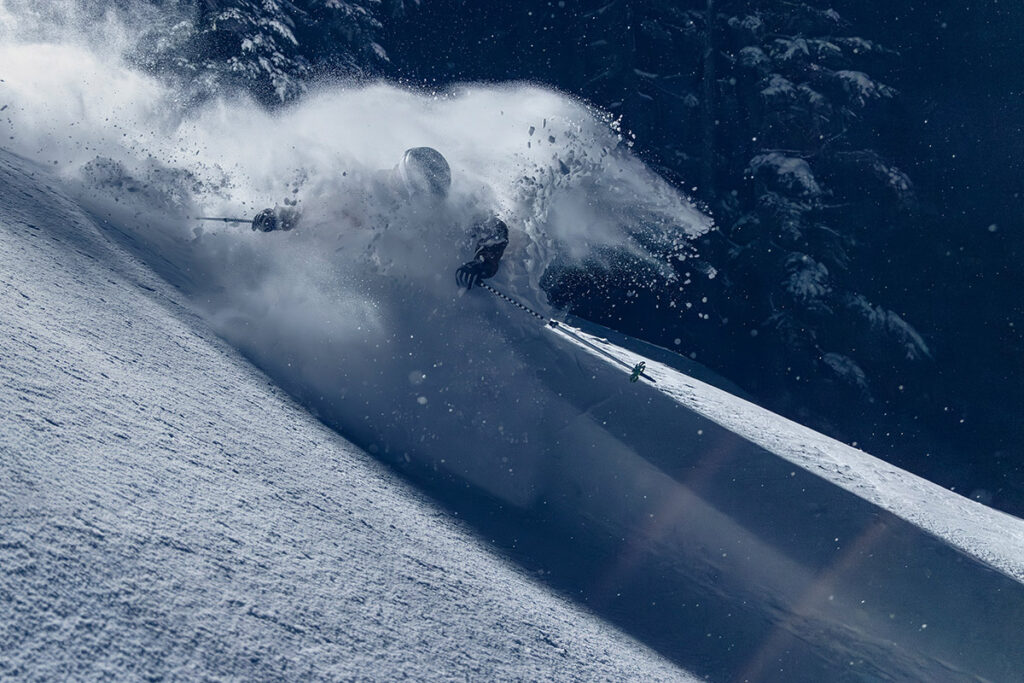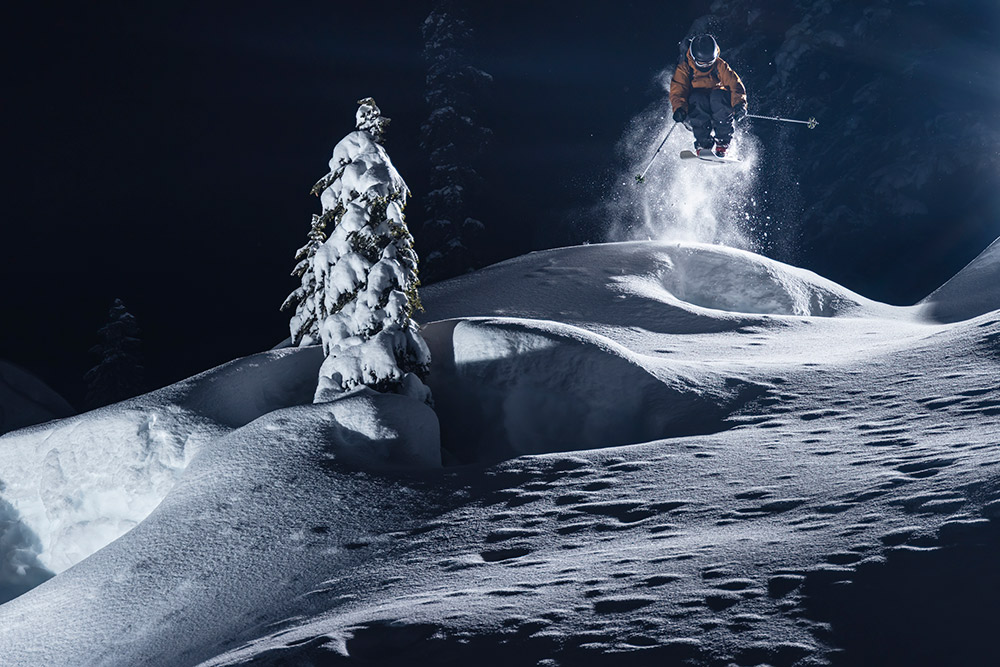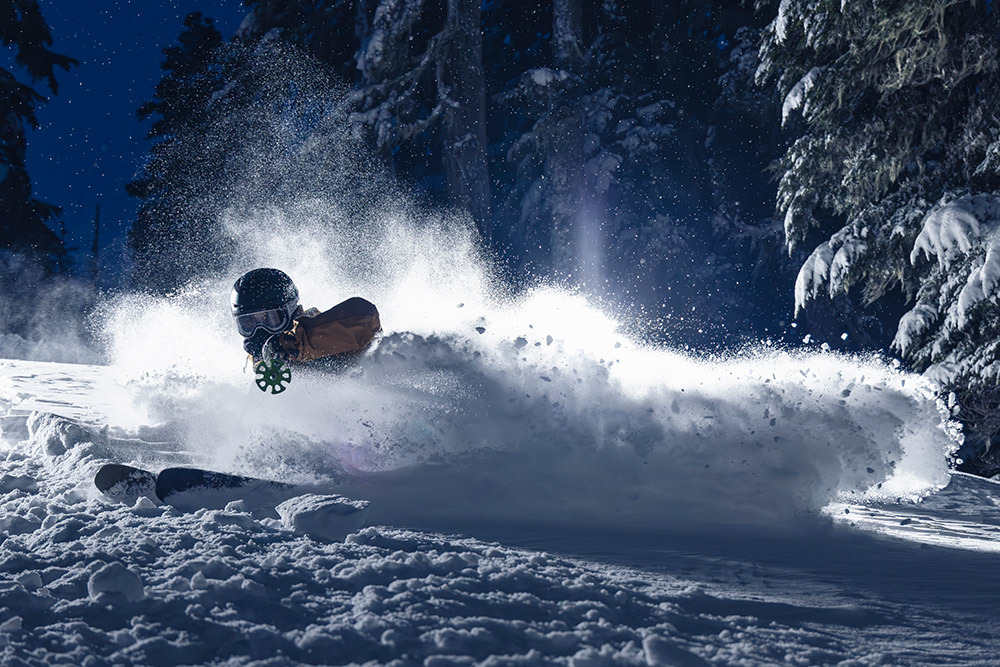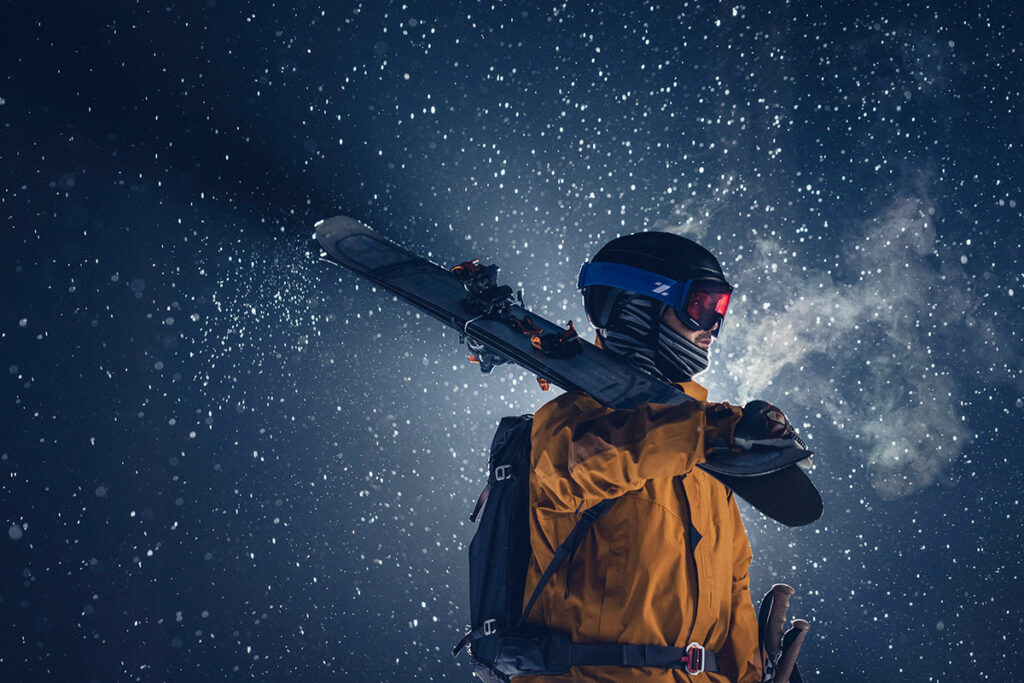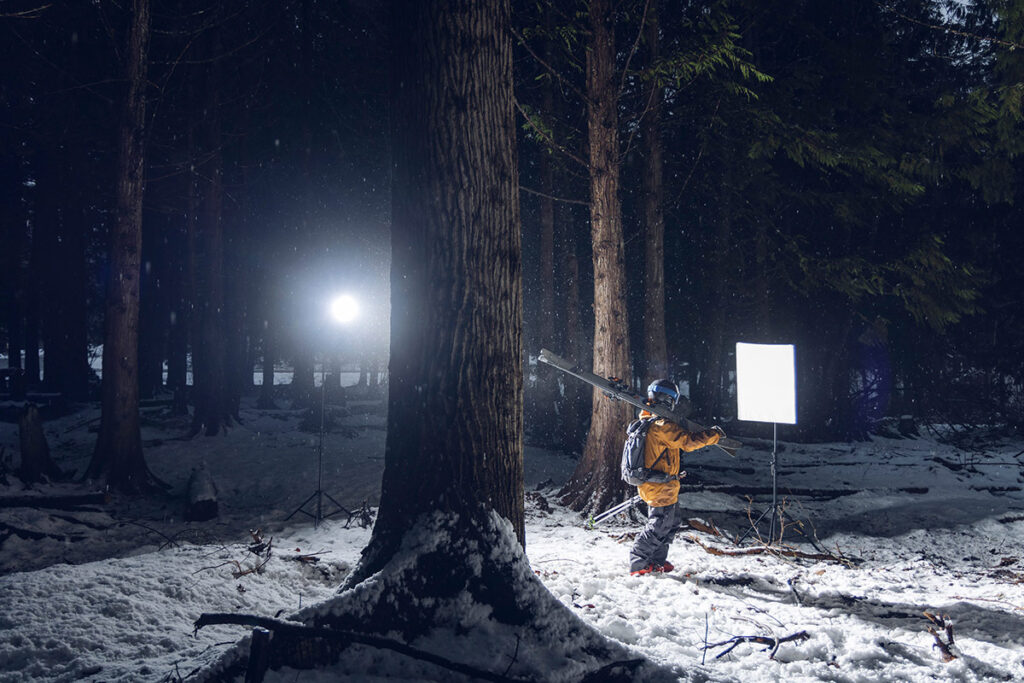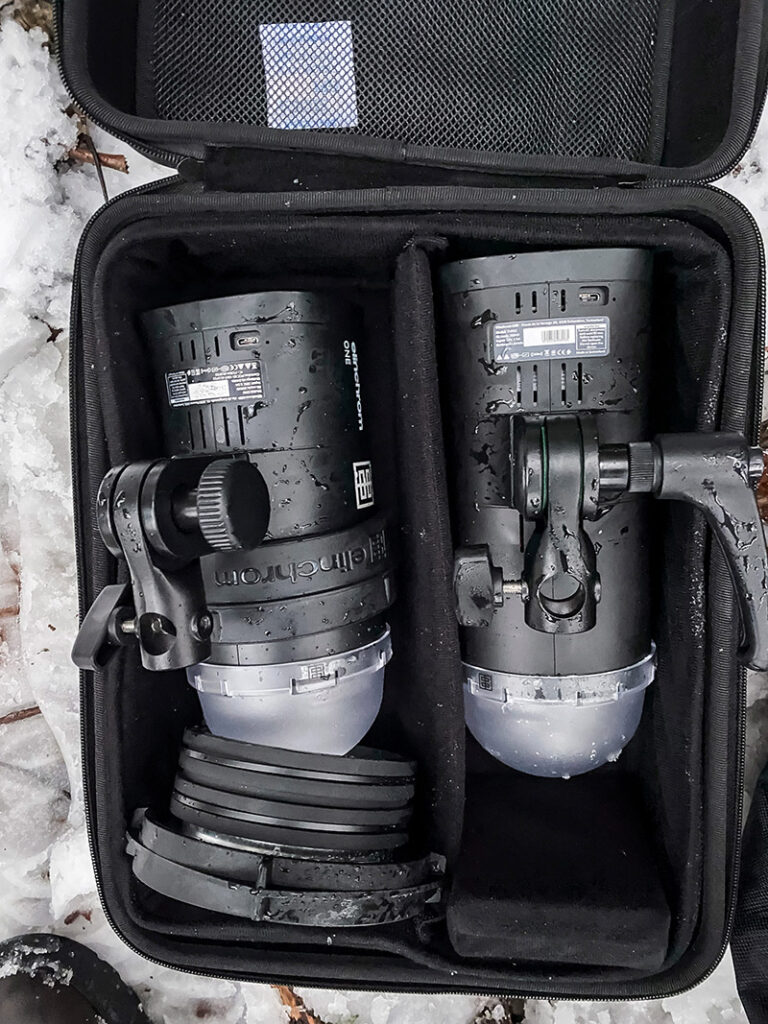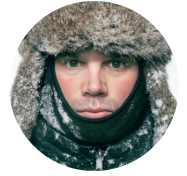While this year was one of the worst winters I’ve ever seen in British Columbia, the challenges inspired me to find new ways to create images in the mountains. As an outdoor photographer, I can’t control the weather but I can play with light and shadow.
The Concept
I’ve always been drawn to sports images shot at night as they are not the most common. In the fall, my friend and skier, Mauri Cambilla, sent me a photo saying he had always wanted to do something like this. It was a night photo of skiing, and it started a conversation and an idea that eventually led to this project.
My goal with this shoot was to capture dynamic action and lifestyle images showcasing the contrast between the serene, snow-covered terrain and the dynamic energy of a skier in the darkness of the British Columbian winters.
The Gear
The main light for this shoot was the THREE, a 261W off-camera flash from Elinchrom with a mono-bloc design. I’ve shot with various lights over the years, including a range of Elinchrom products; most were a power pack with a cable and head design.
“The THREE is no bigger than my Canon EF 100-400 lens and fits in my camera pack, which allowed me to carry only one bag.”
While that design works and has benefits, the mono-bloc design of the THREE was a refreshing and simple experience. The THREE is no bigger than my Canon EF 100-400 lens and fits in my camera pack, which allowed me to carry only one bag. This bag held everything from my camera, flash gear, and light stands/modifiers in addition to my splitboarding and avalanche equipment. Keeping the kit compact and limited is essential for moving in the mountains efficiently; it just requires you to decide ahead of time on what gear you will use.
I also had a second light on hand, an Elinchrom ONE, to add fill and additional light when needed.
Overall, my lighting setups were simple, relying heavily on the High-Performance Reflector from Elinchrom. This reflector is designed to maximize light intensity and give a concentrated beam of light. It would allow me to place my lights further away and still throw the light far enough to light my subjects. In most setups, I would have one light positioned behind the subject, this was used to backlight the snow that was blowing up and in the air. I would then rely on light bouncing off the surrounding snow or add the second light to create fill so my shadows weren’t as dark.
In a few instances, I utilized the Rotalux Recta Softbox 60x80cm and the Rotalux Strip Softbox 35x100cm. These were useful for adding fill light when I wanted more control with a softer source of light. However, needing to be critical in my gear selection based on what I could carry, these didn’t make it in the kit every day.
The Shoot Days
We broke the shooting down over a few days. With more flexibility in conditions, we captured the lifestyle images first. The snow quality wasn’t as much a concern as long as it looked nice. On the first few days out, we tried to shoot some action, but the conditions didn’t align to shoot any skiing that looked worthwhile for what I wanted to capture.
We started with a simple day in town. We didn’t originally have a plan to go out, but we were hanging out and it started snowing unexpectedly. I had my gear with me, and we made the decision to try something to start getting in the rhythm of making these images. We didn’t have much snow on the ground, so I composed the images to hide this, while still capturing the falling snow through backlighting.
This initial day allowed us to dial in everything effectively. While still waiting for snow we scheduled another day to get out.
I had a general spot in mind I wanted to go and we got there early to scout before the sun fully set. Surprisingly, we came across a meadow surrounded by towering trees still covered in snow. Immediately I knew this location would provide the look I was going for. I found a few different frames I wanted to capture and then continued scouting as we waited for it to get dark before coming back to shoot.
The action in these images was minimal and with the scene being completely dark, overpowering ambient light wasn’t a concern so I was pretty free to shoot how I wanted without having to worry about flash duration or HSS to freeze any action.
A single light and a High-Performance Reflector produced all the images in the meadow. I would position the light behind trees so it would shine through, without me seeing the flash directly, and this would backlight the scene to illuminate the trees, my athlete and the snow/fog in the air. The snow was bright, and the covered trees around the meadow bounced light back in to fill my shadows. Since I was aiming for moody and dark images, I didn’t feel the need to bring in a second light for more fill.
When we were getting ready, I watched Mauri putting his skins on at the pickup truck’s tailgate. While not originally part of the plan, the scene caught my eye, so once we were back at the truck that evening I set up for one more shot to capture this feeling of getting ready. This was the one scene where the light varied. I used a strip box to motivate the light coming from the pickup. This filled the bed of the truck and lit Mauri. Feeling it was missing something and lacked the dynamic shape I was going for, I added a second light to illuminate the fog in the air, similar to that of a car driving by.
Fortunately, some snow finally showed up in the forecast and through a few connections, I was able to line up a couple of nights at a backcountry cabin near Whistler. This allowed us to be close to where we wanted to shoot, helping with the logistics of a night shoot. We would head out in the late afternoon, with enough daylight to find our initial locations, and then line up a few options before we were in complete darkness. With a solid plan, we waited for the sun to set before shooting.
I had some specific ideas I wanted to go for, but when you’re in the moment, I always find you need to be adaptable to the conditions around you. With skiing, we always want to shoot untracked snow. So once a track is in the snow, we must move before shooting the next frame. Being adaptable allows you to prepare better and create images you might not expect.
“I would use the HSS technology to darken the scene and rely on my shutter speed to freeze the action”
For the action images, I utilized a few different techniques. The first shots we did were just after sunset where we still had some ambient light. During this time, I would use the HSS technology to darken the scene and rely on my shutter speed to freeze the action.
Once the sky was dark, I switched to Action Mode on the flash, lowered my shutter speed and relied on the fast flash durations to freeze the motion. The THREE displays the flash duration on the screen, which helps when deciding what power to use and knowing before shooting if it will be fast enough to freeze the action.
The goal was to illuminate the snow blowing up in the air when turning and jumping, which played a factor when positioning my light. In some instances, the light was directly behind Mauri as he skied, and in a few other cases, the light would come from the side but slightly behind. This would still create the glow I was looking for and create shadows that fell towards the camera. Not being able to have the lights close to the action, I used the high-performance reflector to position the lights out of the frame, but they would still cast enough light on the scene.
When it started to get darker, and there was no ambient light left, I decided to add a second light to fill in a few shots. To add this fill I would use the ONE and would position it opposite of the backlight. T his would add some fill to the shadows and light up the skier so he wasn’t completely silhouetted. This was just a visual aesthetic, and I decided based on what I was looking for personally.
Since we were skiing in the dark, we needed to add continuous light so Mauri could see while skiing. To accomplish this, I used the modeling lights of the flash. These were running constantly and provided enough light for him to be able to ski safely.
In the end, we captured a few images I had specifically planned, and a couple that were different than I expected, but was just as happy about.
Final Thoughts
Overall, I was really impressed with the THREE, from the size and mono-bloc design to the general function and menu layout, to the ease of attaching and using modifiers.
Flash power was originally a concern for me, especially with overall power lost using HSS. I found once the sun set, I had more than enough power. For some of the action work I do during the day, these lights might not be strong enough to overpower the sun with the distance from the subject required for action, but if the lights could be positioned close to the subject, they would be more than enough.
The flash battery held up well for continuously running modeling lights and operating in conditions below the recommended -10 degrees Celsius.
Shooting at night can be a complicated but rewarding endeavour. With little to no ambient light, the scene can take whatever visual direction you decide. The combination of the THREE and the ONE worked perfectly for this shoot. The combination of size and power made this an ideal light for shooting at night. I was able to carry both and still move efficiently in the mountains.
The gear for this shoot was provided in partnership with Elinchrom.
The set up on the first day out. I used a high performance reflector to backlight the falling precipitation and then used a softbox to create some fill on my subject.
The lights packed up in the case that comes with the kit. Great option for carrying the lights when the car is close and you don’t need to be super portable. The lights got pretty wet, but didn’t miss a beat.
All images © Ben Girardi
Discussed Items



